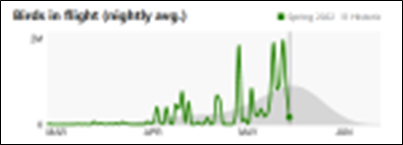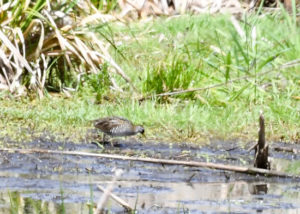(by Pamela Hunt, Senior Biologists for Avian Conservation)
For the third year in a row, NH Audubon organized a spring birding event, this year renamed to “Big Day in May” (vs. the old “Birdathon/Bloomathon”). The goal all three years has been to encourage birders of all experience levels to get outside and enjoy birds, whether in their yards, a local NH Audubon Sanctuary, town, or larger area. A secondary goal – one more attuned to the competitive side of birding – has been to see how many species we can collectively find within the state on a single day. With three years of this approach under our belt, it can be fun to compare and contrast results, so I’ll start with that before diving into what people found in 2022.
One obvious thing is that the number of species has been going up as the number of reporters goes down! Some of this is an artefact of the weather, and some of it might reflect increasing participation by more experienced birders – who are more likely to look for (and find!) unusual species (as we’ll see below). Another major factor is the date: this year was close to a week later than the previous two, allowing a lot more late migrants (e.g., flycatchers, shorebirds) to have arrived. But as folks have commented over the past three years, half the fun is not in the number of species, but in simply enjoying birds and knowing there are others doing it at the same time. One long-term goal of “Big Day in May” is to continue to foster that spirit, no matter how many species anyone finds.
And now back to our regularly scheduled summary.
The spring of 2022 has been a strange one for New Hampshire’s birders. For much of the peak migration period starting in mid-April, we experienced persistent northwest winds. Since birds prefer to move with a tailwind, the arrivals of migrants during this time was boom-bust, with long periods of inactivity punctuated with large numbers. You can see this pattern for NH on the graph below, which is based on data collected from Doppler weather radar. That last big peak in May was the night of May 15 and resulted in high numbers of warblers and other migrants over most of the state – including a spectacular “fallout” along the coast because of fog. The two nights prior to that were Friday and Saturday, and while essentially “normal” for the date, these failed to manifest in large numbers of migrants over the weekend.

It didn’t help that Saturday was very hot, with temperatures near or even above 90 degrees across most of the state. Despite these conditions, at least eight people attempted a “classic” big day, meaning they actively tried finding as many species as possible within a 24-hour period. Many of these efforts started before dawn and ended near dusk, although a few more sensible participants quit by noon or took a siesta. Those who were in it for the long haul reaped the rewards, with top honors going to Steve and Jane Mirick for 137 species entirely within the borders of Rockingham County. Coming in second was Pam Hunt with 123 in Cheshire County, a pretty respectable total considering the lack of an ocean there! That said, she did manage to find eight species of shorebirds and an Arctic Tern, so it felt a little coastal now and then. A final county-level callout goes to Dylan Jackson with 108 species in Sullivan County, although in his own words “I saw almost entirely NOTHING to brag about. Not really a single bird worth noting.” At least three other teams managed to find 100 species or more in multi-town efforts. There were also two reported town-level half-day attempts (by default within a single county!). Ken Klapper managed 101 species in Sandwich and Susan Wrisley found 91 in Hollis.

37 of the 68 reporters, however, stayed as local as you can and birded entirely in their yards. This is a consistent pattern over the last three years, and many of the best comments are from these participants. They find joy in their Baltimore Orioles or the heron fishing in their backyard pond. It’s clear that backyard birders are a big part of this event when you see which species were found by the most participants. American Robin tops out the list with 61 out of 68 reports, with eight more species seen by 50 or more participants (Black-capped Chickadee came in a close second with 58). You can see these statistics in the table at the end of this summary, which also indicates species new to the master list in 2022. That master list is now up to 202 species!
A final fun subset of Big Day involved NH Audubon’s own conservation biologists, who spread across the state in an attempt to collectively find as many species as they could. Carol Foss and Levi Burford explored the Errol area, Chris Martin was in Concord, Diane De Luca walked six miles through the Deering Sanctuary, Becky Suomala went from Concord to the coast and back, and I’ve already mentioned my own effort in Cheshire County. Together, we found 155 species, and now have a number to aim for in 2023! This applies to everyone actually: recall that a team of four birders found 170 species in a single day back in 1996, so surely a collective effort will eventually get us to 200!
Download this report with photos and final bird list in a pdf format.
Photo: We didn’t get a lot of photo submissions this year, but this beautiful photo of Orford pond (top) by Catherine Holland exemplifies why we enjoy being outside looking at birds.
Full “Big Day in May” 2022 Species List
(with number of participants reporting each species)
Asterisks indicate species new to Big Day since 2020
Brant (1)
Canada Goose (34)
Mute Swan (1)
Wood Duck (18)
Mallard (31)
American Black Duck (4)
Green-winged Teal (1)
Ring-necked Duck (1)
Lesser Scaup (3)
Common Eider (6)
Surf Scoter (3)
White-winged Scoter (4)
Black Scoter (2)
Long-tailed Duck (4)
Common Goldeneye (1)
Hooded Merganser (16)
Common Merganser (8)
Red-breasted Merganser (3)
Ring-necked Pheasant (1)*
Ruffed Grouse (9)
Wild Turkey (28)
Pied-billed Grebe (6)
Red-necked Grebe (1)
Rock Pigeon (16)
Mourning Dove (51)
Yellow-billed Cuckoo (1)*
Common Nighthawk (2)
Eastern Whip-poor-will (2)
Chimney Swift (22)
Ruby-thr. Hummingbird (39)
Virginia Rail (5)
Sora (4)
Black-bellied Plover (1)
Semipalmated Plover (4)*
Piping Plover (1)*
Killdeer (20)
American Oystercatcher (1)*
Upland Sandpiper (2)
Dunlin (1)*
Purple Sandpiper (3)
Pectoral Sandpiper (1)*
Least Sandpiper (11)
Semipalmated Sandpiper (1)*
American Woodcock (7)
Wilson’s Snipe (2)
Spotted Sandpiper (14)
Solitary Sandpiper (5)
Greater Yellowlegs (9)
Willet (3)
Lesser Yellowlegs (6)
Black Guillemot (1)
Bonaparte’s Gull (2)*
Ring-billed Gull (7)
Herring Gull (7)
Great Black-backed Gull (5)
Common Tern (5)
Roseate Tern (1)*
Arctic Tern (1)*
Red-throated Loon (3)
Common Loon (22)
Northern Gannet (3)
Great Cormorant (2)
Double-crest. Cormorant (15)
American Bittern (6)
Great Blue Heron (28)
Great Egret (3)
Snowy Egret (4)
Green Heron (12)
Black-cr. Night-Heron (3)*
Black Vulture (1)*
Turkey Vulture (32)
Osprey (17)
Sharp-shinned Hawk (6)
Cooper’s Hawk (7)
Bald Eagle (13)
Red-shouldered Hawk (10)
Broad-winged Hawk (23)
Red-tailed Hawk (23)
Great Horned Owl (2)
Barred Owl (17)
Belted Kingfisher (19)
Yellow-bell. Sapsucker (26)
Red-bellied Woodpecker (36)
Downy Woodpecker (40)
Hairy Woodpecker (37)
Pileated Woodpecker (22)
Northern Flicker (34)
American Kestrel (9)
Merlin (4)
Peregrine Falcon (3)
Eastern Wood-Pewee (5)*
Alder Flycatcher (1)*
Willow Flycatcher (6)*
Least Flycatcher (17)
Eastern Phoebe (41)
Great Crested Flycatcher (19)
Eastern Kingbird (28)
Yellow-throated Vireo (9)
Blue-headed Vireo (20)
Warbling Vireo (24)
Red-eyed Vireo (20)
Blue Jay (57)
American Crow (49)
Fish Crow (7)
Common Raven (30)
Black-capped Chickadee (58)
Tufted Titmouse (54)
Horned Lark (1)
Rough-wing. Swallow (9)
Purple Martin (2)
Tree Swallow (36)
Bank Swallow (3)
Barn Swallow (15)
Cliff Swallow (1)
Golden-crowned Kinglet (2)
Ruby-crowned Kinglet (3)
Red-breasted Nuthatch (18)
White-breasted Nuthatch (35)
Brown Creeper (20)
Blue-gray Gnatcatcher (8)
House Wren (33)
Winter Wren (12)
Marsh Wren (6)
Carolina Wren (21)
European Starling (24)
Gray Catbird (50)
Brown Thrasher (12)
Northern Mockingbird (17)
Eastern Bluebird (28)
Veery (20)
Hermit Thrush (20)
Wood Thrush (22)
American Robin (61)
Cedar Waxwing (4)
House Sparrow (31)
Evening Grosbeak (1)
House Finch (25)
Purple Finch (22)
Pine Siskin (8)
American Goldfinch (53)
Grasshopper Sparrow (5)
Chipping Sparrow (44)
Field Sparrow (7)
Dark-eyed Junco (10)
White-crowned Sparrow (2)
White-throated Sparrow (18)
Vesper Sparrow (1)
Savannah Sparrow (13)
Song Sparrow (43)
Lincoln’s Sparrow (1)
Swamp Sparrow (18)
Eastern Towhee (20)
Bobolink (15)
Eastern Meadowlark (5)
Orchard Oriole (6)
Baltimore Oriole (43)
Red-winged Blackbird (51)
Brown-headed Cowbird (23)
Rusty Blackbird (1)
Common Grackle (37)
Ovenbird (33)
Louisiana Waterthrush (10)
Northern Waterthrush (13)
Blue-winged Warbler (8)
Black-and-wh. Warbler (29)
Nashville Warbler (11)
Common Yellowthroat (32)
American Redstart (25)
Cape May Warbler (2)
Northern Parula (22)
Magnolia Warbler (11)
Bay-breasted Warbler (1)*
Blackburnian Warbler (13)
Yellow Warbler (33)
Chestnut-sided Warbler (27)
Blackpoll Warbler (3)
Black-thr. Blue Warbler (20)
Palm Warbler (4)
Pine Warbler (33)
Yellow-rumped Warbler (25)
Prairie Warbler (18)
Black-th. Green Warbler (25)
Canada Warbler (7)*
Scarlet Tanager (22)
Northern Cardinal (54)
Rose-breasted Grosbeak (30)
Indigo Bunting (12)

